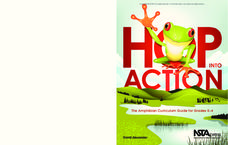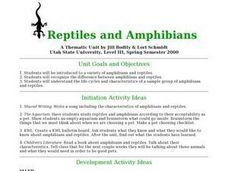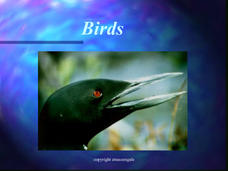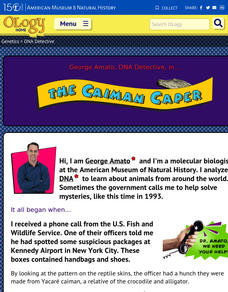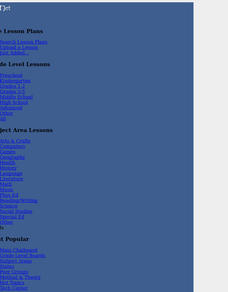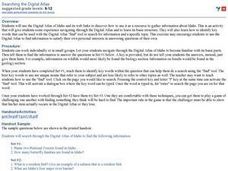Curated OER
Animal Classes-Mammal Birds Fish Reptiles Amphibian
Students learn about the characteristics of each animal classification. In this animal classification lesson students will first learn the characteristics of each classification. Then, they will find animals from given materials and...
National Science Teachers Association
Hop into Action
Young scientists find out what makes amphibians such unique and interesting animals in this simple life science lesson plan. After looking at pictures and discussing the characteristics of amphibians, learners complete a...
Curated OER
The Anaconda
Students examine basic facts about the anaconda. They discuss the length of an anaconda, estimate the length of 33 feet, compare their estimate to the actual length, and decorate the paper snake with colored scales.
Curated OER
Chameleons Are Cool!
Have your learners review what they know about camouflage using this lesson. Learners fill out a graphic organizer listing what they know or have questions about. This could be enhanced with the addition of a writing assignment in which...
Curated OER
Animals Galore
A well-designed lesson which covers the characteristics of the animals found in the six animal groups is here for your young biologists. In it, learners divide up into six groups; the amphibians, reptiles, mammals, birds, fish, and...
Biology Junction
Birds
Birds adapted to almost every climate on the planet, from the Arctic to the rain forests. A presentation focused on birds covers their similarities and differences. It starts with their evolution from reptiles, their many physical...
American Museum of Natural History
DNA Detective
Match up the DNA code. Pupils read the website from the American Museum of Natural History about how DNA can determine whether a skin is from a particular type of reptile. Using the same technique, learners match up products with the...
California Academy of Science
Snakes and Lizards Length and Movement
Snakes and lizards can be very tiny or very long. Your class will get out their rulers to see just how big snakes and lizards can be. They discuss several different reptiles by reading the included animal fact cards, then each small...
American Museum of Natural History
Saving Species
Some scientists dedicate their lives to researching and protecting endangered species. An online lesson teaches about three scientists around the world who do just that. They learn about spiders, mollusks, and reptiles from North...
American Museum of Natural History
Talk to a Titanosaur
Learn all about the Titanosaur with an engaging website that delves deep into the large reptile's physical traits, family history, discovery, and fossil reconstruction.
Curated OER
Lori Schmidt's Lovely Lesson
Young scholars color code a world map by region to show the different amphibians and reptiles that live there. They discuss the Nile Crocodile, Snapping Turtle, Komodo Dragon, Indian Python, and Lacertidae. When completed, they create a...
Curated OER
The Bite of The Caiman
Students study about Caimans-large reptiles that live in Manu. They create a model of the bite of the caiman in a class activity. They calculate the length of the caiman from the size of the model bite.
Curated OER
Ambush Warriors
Students identify four different categories of reptiles and explain how snakes deliver their venom to their prey.
Curated OER
The Great American Alligator
In this alligator worksheet, students read a short essay describing the natural history of this reptile. Then students complete 3 fill in the blank and 3 short answer questions.
Curated OER
Comparing and Contrasting a Desert Reptile and a Rainforest Mammal
First graders compare and contrast two different type of animals while also making predictions, observations, and asking provocative questioning. In this compare and contrast lesson, 1st graders acquire knowledge about why some animals...
Curated OER
Investigating Evolutionary Questions: Bats, Whales, Reptiles, Birds, Animal Classification
Students are guided through a process in which three questions are addressed by retrieving beta hemoglobin sequences from online databases, and using online tools to compare those sequences in student-selected animals.
Curated OER
Small Pond Creatures
Students complete a unit about the different creatures that can live in a small pond habitat. They create a glossary, create a class Small Pond mural, develop a Frog Fact File, read a variety of books, and conduct research for a report...
Curated OER
Plants and Animals
Students find common needs between plants and animals. In this plants and animals lesson students compare that both plants and animals need food and water. They also find the differences between plant and animal needs.
Curated OER
Cool It
Students simulate lizard temperature regulation. In this Science lesson, students use a thermometer as a pretend lizard. Students must keep their lizard within a particular temperature range while moving through a specified course.
Curated OER
Reptile and Amphibian Conversions
In this conversion worksheet, students read about given reptiles and amphibians and converts lengths and weights as instructed.
Curated OER
Searching the Digital Atlas
Learners become familiar with the tools of a digital atlas. They use a digital atlas of Idaho to located specified information. Students identify national forests, locate butterfly families, find examples of resident fish, and explore...
Curated OER
Animal Classification
In this animal classification worksheet, students will complete a graphic organizer by writing in the different animal groups: birds, mammals, reptiles, birds, and amphibians.
Curated OER
Reptiles and Birds
In this classification worksheet, students review 5 vocabulary terms that describe reptiles or birds. These 5 terms are placed into a crossword puzzle.
Other popular searches
- Reptiles and Amphibians
- Reptiles Worksheets
- Reptiles Life Cycles
- Reptiles Hands on Activities
- Reptiles Amphibians
- Amphibians and Reptiles K 2
- Reptiles & Amphibians
- Marine Reptiles
- Reptile Excretory System
- Reptiles Lesson Plans
- Reptiles Introduction
- Collections on Reptiles



